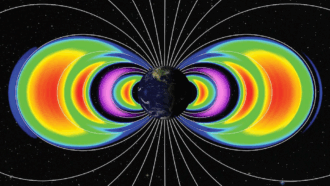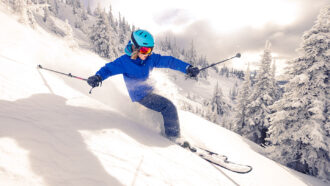Analyze This: Can you outrun these geological disasters?
Yes — and well probably not
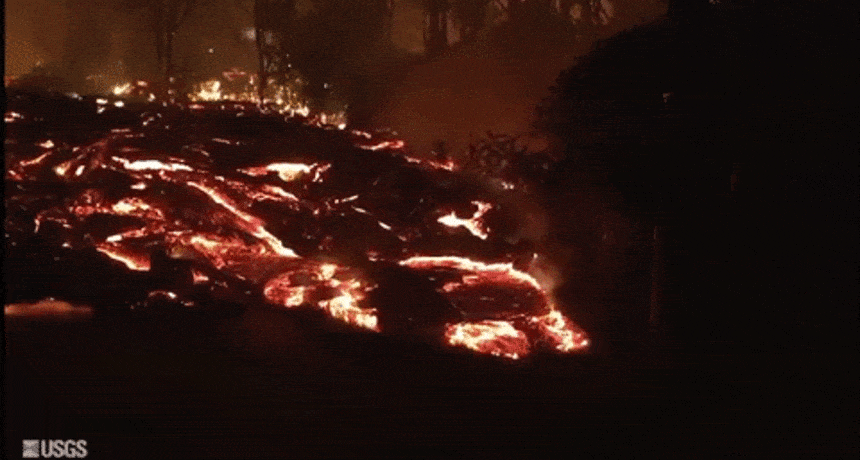
This May 2018 video of lava flowing down a road was captured during the eruption of Kilauea on the island of Hawaii.
USGS/Youtube
Share this:
- Share via email (Opens in new window) Email
- Click to share on Facebook (Opens in new window) Facebook
- Click to share on X (Opens in new window) X
- Click to share on Pinterest (Opens in new window) Pinterest
- Click to share on Reddit (Opens in new window) Reddit
- Share to Google Classroom (Opens in new window) Google Classroom
- Click to print (Opens in new window) Print
Red hot lava races down the slopes of a volcano, along with billowing clouds of ash, toxic fumes and huge rocks. People, dinosaurs and vehicles are desperately speeding away, staying just ahead of the molten rock and ominous clouds. Because, well, life finds a way (it has to). If this sounds familiar, that’s because this is a scene from the recent summer movie blockbuster, Jurassic Kingdom.
Aside from the dinosaurs, though, just how realistic is this scenario? Could people actually outrun the dual dangers of lava and a pyroclastic flow? What about other geological disasters, such as landslides or avalanches? The movies, it turns out, aren’t always totally fiction.
Lava flow
Lava is the molten rock that comes out of a volcano. How quickly lava flows depends on factors such as its chemical composition, its temperature, and its gas and fluid content. Researchers measure its speed with the same radar gun that police use to catch speeding cars. And, they find, hotter lavas can move pretty swiftly when they contain plenty of gas, such as water vapor, carbon dioxide and sulfur dioxide.
There are two main types of lava: basaltic (Bah-SAAL-tik) and andesite (AN-deh-syte). Basaltic lava is generally more fluid and free-flowing. It tends to produce low-profile shield volcanoes, such as Kilauea in Hawaii. In contrast, andesite lava contains more silica than basaltic lava. That makes it thicker, creating slower lava flows and taller volcanoes, such as those found in the Andes.
Occasionally, lava can travel briskly, such as when it’s in a lava channel, lava river or lava tube. These are pathways that direct and insulate the lava flow, allowing it to move much more swiftly. These pathways form when friction slows the outer edges of a lava flow. As those edges cool they also crust over and harden. This allows them to channel the lava flow, like the edges of a creek or river channels water.
The rest of the time, though, a person should be able to escape a lava flow easily.
Pyroclastic flow
This is the movie industry’s classic type of volcanic eruption. Here, a giant cloud of ash, toxic fumes and large chunks of solidified lava travel downhill in the company of searing hot gases — some as hot as 1,000° Celsius (1,830° Fahrenheit). Most people unfortunate enough to be near such a fast-moving event won’t escape it. The Volcán de Fuego in Guatemala, for instance, released a lethal pyroclastic flow during an eruption this summer. It killed more than 100 people.
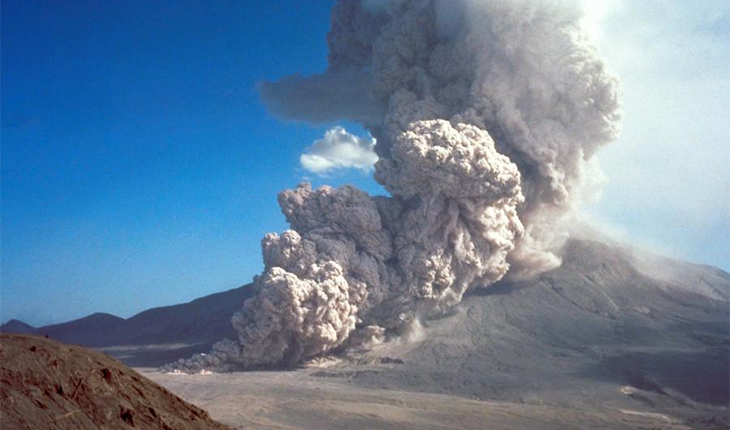
Landslide
Sometimes the rocks and soil on a slope give in to gravity. The resulting downhill flow is known as a landslide. Heavy rains and earthquakes are among events that can trigger a landslide. Human alterations to the environment can aggravate the risk that this will happen. Examples of such changes are stripping plants from hillsides or cutting into hillsides to build roads. Now this land may erode and give way during rains.
“Landslide is a generic term for a kind of land flow movement,” explains Dave Petley. A geographer and earth scientist, he works at the University of Sheffield in England. What a landslide looks like and how fast it moves depends on many things. Most land flows move just a few centimeters (inches) a year. Others can move very fast and with little warning.
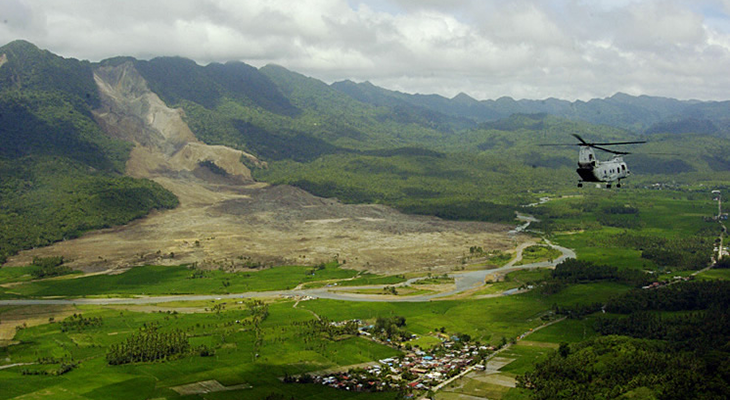
Mudslides are a specific type of landslide where debris and dirt mix in with water. Mudslides tend to be slower than other land flows. They also have the potential to be very powerful and to pick up debris as they travel.
Lahar
Sometimes water mixes with volcanic sediment and debris to create a powerful, fast-moving river that gushes down a volcanic slope. Its structure tends to resemble flowing concrete. Lahars can be triggered by severe rainfall in a volcanic area that has lots of loose sediment. They also can develop when a volcanic eruption melts glacial snow on the sides of a volcano.

The Colombian town of Armero used to stand in the center of this image, in South America’s Lagunilla River valley. But in November 1985, the eruption of the Nevado del Ruiz volcano created a lahar that obliterated the town. Jeffrey Marso/USGS 
This aerial photo of the town of Armero in Colombia shows the only buildings left standing after the town was demolished by lahars. The town’s location, in the Lagunilla River valley, magnified the impact of this disaster. USGS
In 1985, the Nevado del Ruiz volcano in Colombia erupted. Pyroclastic flows burst from the volcano. These melted glaciers on the mountain’s slopes. The several lahars that this created poured down the mountain at high speed. Nighttime lahars swept through the town of Amero with no warning, leaving 20,000 dead.
Avalanche
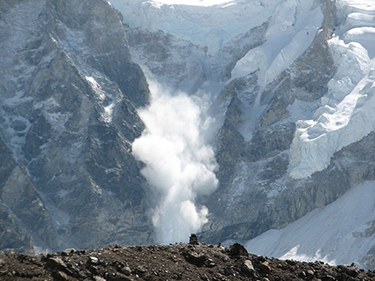
Large amounts of snow sometimes break off a mountain or hill to tumble downward — often without warning. These avalanches can be triggered when something disturbs a snowpack, such as a skier or an earthquake. The most dangerous avalanches, known as dry slab avalanches, occur when a very cold and very dry snowpack destabilizes. The unstable snow now rushes downhill, fanning out and picking up more snow along the way, which further feeds the avalanche.
Data:
| Disaster | slowest speed (kph)* | fastest speed (kph)* |
|---|---|---|
| lava (andesite) | 0 | 2 |
| lava (basalt) | <1 | 10 |
| human | 5 | 32 |
| car | 0 | 241 |
| mudslide | 16 | 56 |
| avalanche (dry slab) | 30 | 130 |
| landslide | 88.5 | 161 |
| lahar | 3.5 | 80.5 |
| pyroclastic flow | 80.5 | 724 |
*All speeds are presented in kilometers per hour (kph) and are estimates that can vary depending on situation and topography.
Data Dive:
- Use the data to create a graph or chart. Be sure to use appropriate labels.
- What is the most surprising thing about these data?
- Convert the table from kilometers per hour to miles per hour.
- Could you escape a lava flow on foot? What about in a car? (Hint: Take into account where these events might occur.)
- Which three disasters would you have the most chance of escaping on foot?
- Which disasters would you have the most chance of escaping in a car?
Analyze This! explores science through data, graphs, visualizations and more. Have a comment or a suggestion for a future post? Send an email to sns@sciencenews.org.


